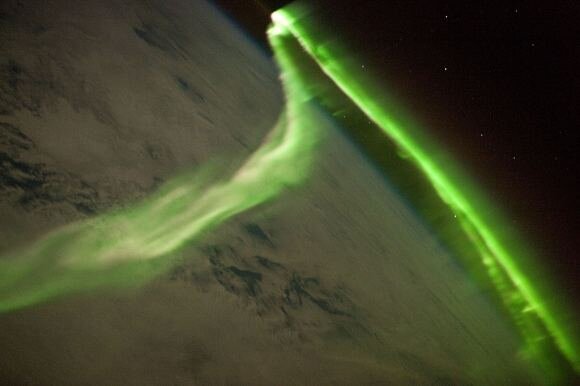“A great fire appeared in the sky to the North, and lasted three nights,” wrote a Portuguese scribe in early March, 1582. Across the globe in feudal Japan, observers in Kyoto noted the same fiery red display in their skies, too. Similar accounts of strange nighttime lights were recorded in Leipzig, Germany; Yecheon, South Korea; and a dozen other cities across Europe and East Asia.
It was a stunning event. While people living at high latitudes were well aware of auroras in 1582, most people living closer to the equator were not. The solar storm that year was unlike anything in living memory, and it was so strong it brought the aurora to latitudes as low as 28 degrees (in line with Florida, Egypt, and southern Japan). People this close to the equator had no frame of reference for such dazzling nighttime displays, and many took it as a religious portent.
“All that part of the sky appeared burning in fiery flames; it seemed that the sky was burning,” wrote Pero Ruiz Soares, an eyewitness in Lisbon, and the author of a 16th-century Portuguese chronicle. “Nobody remembered having seen something like that… At midnight, great fire rays arose above the castle which were dreadful and fearful. The following day, it happened the same at the same hour but it was not so great and terrifying. Everybody went to the countryside to see this great sign.”
These centuries-old accounts of the 1582 solar storm were recently uncovered by researchers hoping to learn more about the event. Just as early modern peoples sought meaning in the auroras, modern day scientists are also eager to understand the fiery skies of 1582. That massive solar storm, and other storms like it, are important indicators of historical solar weather patterns. Understanding them can help predict future solar activity.
The historical record seems to suggest that major storms like the one in 1582 are, at minimum, a once-in-a-century occurrence, and so we should expect one or more of them to hit Earth in the 21st century.
Find your dream job in the space industry. Check our Space Job Board »
While pre-modern solar storms had little effect aside from their incredible auroras, a major solar storm today could do billions of dollars of damage and shut down power grids worldwide. A moderately large storm in 1989, for example, completely knocked out the power grid in Quebec, and a more powerful storm could do worse. The most severe solar storm in recorded history, the Carrington Event of 1859, were it to happen now, would be far more damaging, although at the time, it only affected early telegraph lines.
Solar storms are caused by disturbances in the sun’s atmosphere. High energy explosions known as solar flares can be accompanied by an enormous rush of solar wind known as a coronal mass ejection. These fast-moving solar particles interact with Earth’s magnetosphere, producing vibrant auroras and interfering with electronics.
Solar storms can also carry with them deadly doses of radiation. Earth’s protective magnetosphere keeps us safe from their effects, but as NASA and its partners look to return to the moon and beyond in the coming decades, an accurate model of solar weather is going to be vital for mission planning. This lesson was learned during the Apollo era, when a solar storm blasted by Earth in August 1972. The storm would have been fatal to astronauts, had they been on the moon at the time. Luckily, Apollo 16 had returned to Earth in April that year, and Apollo 17 did not launch until December, so catastrophe was avoided. Careful planning, and a little luck, will be required to keep future lunar astronauts safe.
Should we be worried about future solar storms? Perhaps. At the very least, we ought to be prepared for them, just like any other natural disaster. Since the 1989 power outage, the power generation industry has begun working on mitigation techniques, and taken preventative measures to make power grids more resistant to solar weather, but it’s hard to be fully prepared. When the next big solar storm comes, and it will come someday, we may not be fully ready for it. But one thing is for sure: it’s going to put on one heck of a show.
Provided by: Universe Today
More information: Hattori et al. Occurrence of Great Magnetic Storms on 6–8 March 1582. ArXiv Preprint (2019). arxiv.org/abs/1905.08017
Carrasco et al. Portuguese eyewitness accounts of the great space weather event of 1582. ArXiv Preprint (2021). arxiv.org/abs/2103.10941
Image: An aurora caused by a coronal mass ejection in 2010, as seen from the International Space Station.
Credit: NASA, ISS Expedition 23 crew











